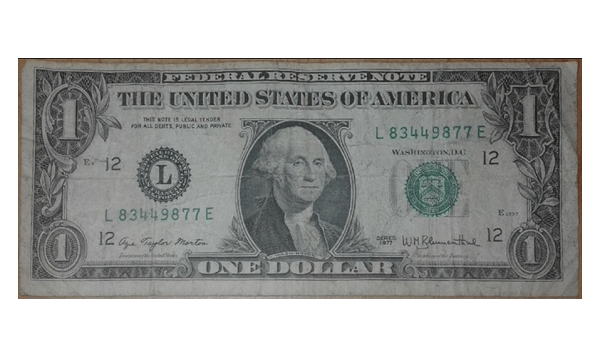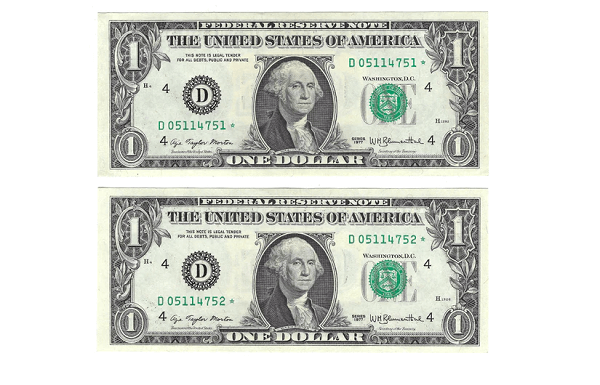1977 1 Dollar Bill Value – The 1977 one dollar bill stands as a ubiquitous note in American currency, commonly circulated yet holding intriguing aspects that collectors and enthusiasts find captivating. The standard bills from this series might not command substantial value beyond their face worth, but a deeper exploration into this denomination reveals hidden treasures within the realm of star notes and specific conditions.
A prime example, the Series Of 1977 A $1 Federal Reserve Bank Note Of San Francisco, California Fr#1910-L (LI Block), offers a glimpse into the distinctive features of these bills.
Graded as Extremely Fine 40 (Misalignment Error) with an “Overprint Misaligned” annotation by PMG, this note displays unique traits, including a creamy white/off-white paper color, subtle folds visible on the reverse, notable misalignment on the obverse, and slightly uneven margins.

Notably, the total number of notes printed in this series amounts to a staggering 432,280,000, emphasizing the prevailing availability of these bills.
Federal Reserve Notes, serving as the primary form of banknotes in the United States, derive their denomination in United States dollars (USD).
The legislative foundation for these notes was established through the Federal Reserve Act of 1913, culminating in the creation of the Federal Reserve System and the authority to issue Federal Reserve Notes as legal tender.
Prior to this centralization, commercial banks issued their own notes, with the First Bank of the United States, chartered by Alexander Hamilton in 1791, marking an early instance of a central banking institution.
The evolution of these banknotes saw the emergence of the ‘Series of 1914,’ featuring larger-sized notes with denominations of $5, $10, $20, $50, and $100, initially adorned with red seals and later transitioning to blue seals.
These earlier notes boasted dimensions averaging 7.375 x 3.125 inches (187 x 79 mm) until a size reduction in 1928 aimed at cost-saving measures.
1977 One Dollar Bill Specifications
- Denomination: $1.00 USD
- Type: Federal Reserve Note
- Seal Varieties: One: Green
- Series: Two: 1977, 1977A
1977 1 Dollar Bill Value
In general circulation, most 1977 one dollar bills tend to hold their face value of $1. However, uncirculated standard bills can fetch a premium. Notably, star notes, replacements printed by the Federal Reserve, stand out as rare and consequently more valuable.

For both the 1977 series $1 bills and the 1977A series $1 bills, their value is in uncirculated condition with an MS 63 grade averages around $4.50.
“Please note that the values mentioned herein are approximate and subject to market fluctuations based on condition, scarcity, and collector demand. For precise valuations or further insights, a thorough assessment by professionals or experienced collectors is recommended.”
1977 1 Dollar Bill Star Notes
Star notes, distinguishable by a star symbol at the end of the serial number, represent replacement bills and carry increased rarity and value. The 1977 series $1 star notes in very fine condition command prices ranging from $3.50 to $5.50.
In uncirculated condition with an MS 63 grade, these notes can sell for approximately $8 to $10. Interestingly, star notes issued from the Federal Reserve Bank of Boston hold a higher value.
Likewise, the 1977A series $ 1-star notes, in very fine condition, holds a value range of $3.50 to $4.50. In uncirculated condition with an MS 63 grade, prices hover around $8 to $10, with higher value attributed to star notes from the Federal Reserve Banks of Boston and Cleveland.
1977 $1 Bill Grading System
Understanding the grading system aids in comprehending the condition and value of these bills:
- Very Fine: Notes in circulation but with minimal wear, retaining relative crispness, and minor creases, folds, or smudges.
- MS 63 Choice Uncirculated: Bills exhibiting no signs of circulation, maintaining original crispness and precise centering.
Conclusion
The 1977 one dollar bill might not inherently carry significant monetary value, but the allure lies in the diverse varieties and conditions these bills embody.
Exploring the realm of star notes, specific grading, and historical context reveals a nuanced perspective on the worth and fascination associated with this ubiquitous denomination.
For collectors and those intrigued by the nuances of currency, delving into the intricacies of the 1977 one dollar bill opens doors to a captivating journey through the world of American currency, where rarity, condition, and historical significance intertwine to offer a deeper understanding and appreciation.